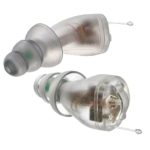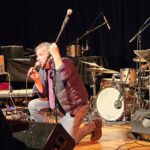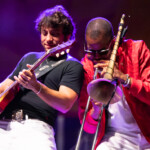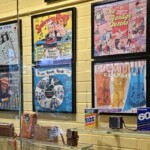 You’ve undoubtedly been on stage or in the audience when the music is great, but you wish you had a little more control over the volume. Sometimes, it’s actually painful and sets your teeth to rattling. Foam, wax or silicone earplugs used to be your best bet, but those just muffle the sound in order to protect your ears for the long haul.
You’ve undoubtedly been on stage or in the audience when the music is great, but you wish you had a little more control over the volume. Sometimes, it’s actually painful and sets your teeth to rattling. Foam, wax or silicone earplugs used to be your best bet, but those just muffle the sound in order to protect your ears for the long haul.
Etymōtic hopes to change that with its Music-Pro high-fidelity electronic musician’s earplugs. For use by anyone involved in a live performance—from musicians and stage crew to audience members—they automatically change their output levels: as external sound levels increase, the earplugs gradually provide 9- or 15-dB sound reduction, depending on the protection you choose. When sound is at safe levels, hearing is supposed to be natural, as if there is nothing in your ears at all.
I began by experimenting at home with loud noises. My wife marches in a drum and bugle corps, and drum corps members often suffer hearing problems. I grabbed the marching snare she keeps in her piano studio, put the plugs firmly in my ears, and banged haphazardly on the drum. The plugs immediately kicked in. The light, high-end hiss disappeared, and the drumming came through like butter, sounding exactly like it should sound, only without the percussive shock to my ears.
 Onstage, I was able to hear through the earplugs in a very natural way when the protection wasn’t in play, though I found the sound similar to what I imagine a hearing aid would provide. I could hear everything with a good amount of detail and nuance, though it was a bit pegged on the high end of the sound spectrum. I got used to this fairly quickly, and I was quite amazed at the sound quality.
Onstage, I was able to hear through the earplugs in a very natural way when the protection wasn’t in play, though I found the sound similar to what I imagine a hearing aid would provide. I could hear everything with a good amount of detail and nuance, though it was a bit pegged on the high end of the sound spectrum. I got used to this fairly quickly, and I was quite amazed at the sound quality.
 If you are around loud music or sound of any kind, Etymōtic Music-Pro earphones offer excellent protection while still allowing wearers to communicate naturally. As an audience member, a member of a loud band, or any kind of backstage professional, they’re excellent. I did recall days past, as a non-musician working in scene shops and construction sites, wishing that equipment like this was available. How great is it to have strong protection, but only when you need it? When I think back to all the times I took ear protection off so that I could hear what someone was saying, or just didn’t wear any because of the hassle! I imagine I wouldn’t have done myself damage if these plugs existed back then.
If you are around loud music or sound of any kind, Etymōtic Music-Pro earphones offer excellent protection while still allowing wearers to communicate naturally. As an audience member, a member of a loud band, or any kind of backstage professional, they’re excellent. I did recall days past, as a non-musician working in scene shops and construction sites, wishing that equipment like this was available. How great is it to have strong protection, but only when you need it? When I think back to all the times I took ear protection off so that I could hear what someone was saying, or just didn’t wear any because of the hassle! I imagine I wouldn’t have done myself damage if these plugs existed back then.
It may sound obvious, but if the music isn’t loud enough to require protection, musicians shouldn’t use Music-Pro. During acoustic performances, I found that my voice drowned out any other sounds, including the voice of my duo partner, which made harmony singing difficult. Had we both been running hot through large stage monitors it would likely have been different, but for quieter, acoustic music, the “stuffy head” feeling of having plugs in my ears made it difficult to sing and play with the control needed. Be aware that these are not the same as in-ear monitors.
Music-Pros come in a lovely box that looks like it might hold a diamond ring. Several sizes of ear adapters, including both silicone sliders and foam plug attachments, making a good fit possible for anyone—be aware that the fit is vital. Take time to find the attachment that fits comfortably and snugly, or the benefits of the plugs are lost.
I look forward to using them with rock shows…assuming I can get them away from my wife, who’s already plotting to borrow them for drum corps.
—Adam Moe
The fiddler for the Minnesota-based folky-tank duo Pushing Chain, Adam Moe lives in Duluth, Minnesota, where, for three or more months a year, many people wear earmuffs.







Be the first to comment!